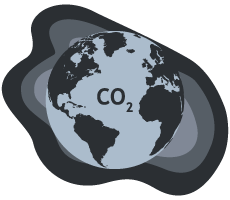Kaya identity: definition, challenges and climate solutions

Gross domestic product (GDP), population and global energy consumption: what is the relationship between them and global CO2 emissions? This is what the Kaya identity tries to explain. It is the mathematical formula that sets out possible solutions to reduce global warming. In this article, we'll look at what is the Kaya identity, how it works, and what steps you can take to reduce your CO2 emissions.
What is the Kaya identity?
Developed by Japanese economist Yoichi Kaya in 1993 in his book Environment, Energy, and Economy: strategies for sustainability, the mathematical formula by the same name defines itself as the result of the following ratios:
The Kaya identity's formula
- CO2 = Population x [GDP / Population] x [Energy / GDP] x [CO2 / Energy]
In other words: global CO2 emissions from a human source = global population x quality of life x energy intensity x intensity of carbon in the energy mix.
By revitalising the relationships between different components in an ecosystem, this mathematical formula allows one to take a global approach to CO2 emissions related to human activity and therefore take whatever action is necessary to break the trend we are currently on and lower them by the year 2050 - one that many governments around the world have set to achieve their climate change goals.
Factors in the Kaya identity
The Kaya identity links the following four factors:
- Global carbon dioxide emissions, in carbon dioxide (CO2);
- Global primary energy consumption, in Ton of Oil Equivalent (TOE);
- GDP, in dollars ($);
- Global population, in billions.
It is worth noting each of the factors to achieve the global objective of reducing carbon dioxide emissions.
Kaya identity and climate
To limit the increase in the average temperature of the Earth’s Surface and to avoid global warming of over 1.5°C when compared to pre-industrial levels from here to 2050, it is essential to divide CO2 emissions by 3 from here to 2050, on a global scale.
I stand up for real climate action, I offset my CO2 emissions!Global warming is everyone's business! To offset your CO2 emissions and participate in the energy transition.
Send us an e-mail
Limit global warming

It is imperative to act in a swift and radical manner in all areas in order to limit the impact of climate change on our environment.
- Population: except for demographic shocks (wars, pandemics, etc), it is estimated that the Earth’s population will reach 8.5 billion people by 2050, according to the United Nations.
- Quality of life: it is estimated by dividing the global GDP by the world’s population. Assuming a minimum growth of 2.2% per year of economic production and at the same time, of the world’s population and the constant carbon content, the result would be an increase of CO2 emissions, rather than a decrease.
This mathematical formula, therefore, leads us to re-assess all our current economic policies.
Divide CO2 emissions by 3
In order to divide global greenhouse gas emissions by 3 by 2050, taking into account the increase in population and quality of life, it would be necessary to divide the ratios of Energy/GDP and CO2/Energy by 10, which also is equivalent to dividing each of these ratios by 3.

- Energy/GDP: represents the energy intensity, i.e. the amount of energy used (in kWh) necessary to create a monetary unit, meaning to manufacture a product or provide a service. This intends to encourage us to rationalise our use of energy.
- CO2/energy: represents the intensity of carbon in the global energy mix. This relationship demands a reduction in CO2 emissions in the production of energy, in particular through the promotion of energies low in carbon, such as renewable energy.
- The Kaya identity defines two global objectives:
- A gain in carbon efficiency in our energy production;
- An increase in energy efficiency in our production.
Therefore, dividing each of these ratios by three, means a global decision to be reached very quickly in favour of energy efficiency and decarbonisation from the energy mix. The obvious solution to this calculation is, therefore, advancing towards zero CO2 emissions as soon as possible.
Kaya identity and sustainable development
This mathematical formula links to the idea of sustainable development by illustrating the urgency of taking measures to reduce greenhouse gas emissions into the atmosphere.
Contributing towards sustainable development includes, evidently, raising awareness through initiatives such as calculating one’s carbon footprint. This calculation allows us to understand how our consumer habits have a negative impact on the environment and how to limit it.
Reaching the Sustainable Development Goals (SDG) requires a collective agreement and to advance towards a society which is more respectful of the environment, whilst at the same time working towards economic growth and sustainable development.
What are the Sustainable Development Goals?First made public at a UN summit in 2015, the SDG’s are a set of 17 common goals designed to protect the planet, the environment, and ensure an improvement of social well-being for all. Governments across the world signed up to the commitments, which include targets such as ending poverty, reducing inequality, taking climate action, and providing clean and affordable energy.
How to reduce your carbon footprint?
While the Kaya identity sets out to find areas to improve efforts to reduce CO2 emissions on a macro scale and provide decision-makers with data that they can use to base their policy decisions, as individual citizens we can all play our part in reducing emissions by making changes in all areas of our lives.
Here are some of the key areas where you can make changes, reduce your CO2 emissions, and help tackle climate change.
Transport

- Avoid using your car for short journeys and instead walk or cycle;
- Use public transport rather than your car;
- If you need your car, see if you can share a ride with other people;
- Make use of electric cars and scooters and other means of sustainable transport if they are available where you live;
- Consider buying an electric car if you need your own means of transport;
- Avoid flying if possible. Planes are one of the largest contributors to CO2 emissions around the world.
Energy use at home
- Don’t leave your mobile phone charger plugged in all the time;
- Switch off lights when you don’t need to use them, and consider switching to LED bulbs too;
- Turn off electrical devices such as laptops and TVs rather than leave them on standby;
- Think about switching to a green energy provider to reduce the use and dependency on fossil fuels;
- Consider your heating requirements at home. Not only can you reduce your emissions, but you can also save on your bills.
Food
- Reduce the amount of meat and animal products you eat;
- Recycle organic waste – most local councils in the UK can provide you with a food waste bin which they will collect;
- Buy local produce and limit CO2 emissions from food that needs to travel large distances;
- Choose foods that have been produced by organic farming.
Waste management and recycling
- Recycling plays a key role in reducing your CO2 emissions. Make you properly recycle items such as plastic, aluminum, and even your clothes.
- Choose reusable shopping bags rather than plastic bags;
- Many businesses have already committed to reducing plastic, but you can help by choosing products that have little or no plastic packaging.
Water use at home
- Use your dishwasher and washing machine only when they are full;
- Cover your pots while you cook and only boil the amount of water you need;
- Think about collecting the cold water from the first moments of your shower and use it to water plants in your garden.
Discover other practical guides regarding the protection of the environment and the fight against global warming.
